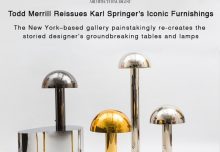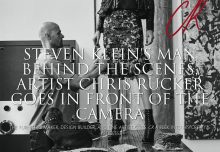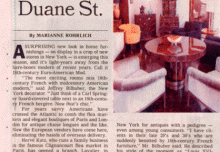Art & AntiquesDesign RevolutionMay 2008
DESIGN REVOLUTION
By Roberta Maneker | May 2008
Mid-Century Modern is on a tear. Ambitious shows are taking place in New York, Los Angeles, Palm Springs and Miami, Auction records are falling with each new sale. Furniture long ignored and often denigrated has over the past decase not just survived but revived amid a buzzing market. The genre is tricky to define, though, because it’s not confined to a single canon. Modernist furniture crosses a lot of lines and includes high-style glamour, ascetic simplicity, sharp angles, sinuous curves and even garden-variety kitsch.
American Modernism got a kick-start when emigrating European architects, in the period between the world wars, created innovative houses in Southern California that spoke to the uniqueness of the state’s climate, topography and paucity of tradition. Richard Neutra and Rudolf Schindler, both Austrian-born, and the Hungarian Paul Laszlo created renegade one-story homes that blurred the line between inside and outside, with an abundant use of glass that created light-filled, airy living spaces (enabled by post and beam architecture). Their work gained national attention, not least because of the acclaimed architectural art photography of their friend and booster, Julius Shulman.
California continued for years to be a source of architectural experimentation. Between 1945 and 1966, the now-defunct magazine Arts & Architecture (1938-1967) commissioned a group of prominent architects to design so-called Case Study Houses, efficient and inexpensive homes that could help ease the housing shortage after World War II. Most were in the Los Angeles area, by architects including Neutra, Eero Saarinen, Pierre Koenig and Charles and Ray Eames, and were made famous by some now highly collectible Shulman photographs. Meanwhile, California developer Joseph Eichler built more than 11,000 “California Modern” ranch houses, mostly in northern California, between 1950 and 1974. (These sleek and airy, affordable homes were a far cry from the barebones tract-community Levit-towns emerging on the East Coast, which paid more attention to economies than style.)
California Modernism caught the public zeitgeist, fueled by its practicality and by the forward-looking can-do optimism that emerged after the war. Design, too, was moving in exciting new directions. Note the plural. This mid-century furniture covers a wide swath, and the designers can be roughly segmented into three groups, none making furniture that remotely resembled your grandmother’s living room. Let’s call them “hot,” “warm” and “cool,” recognizing that this is a loose schematic and that many designers can’t be neatly pigeonholed.
Designers in the first group made luxurious, elegant and often dramatic pieces for wealthy clients, some of whom, of course, belonged to the affluent entertainment industry, which has a penchant for electric glamour. Their furniture complemented both the au naturel California ranch houses and the sumptuous mansions of Beverly Hills. The most decorative designer in this grouping was Laszlo, who was noted as much for his elegant interiors as his architecture. His furniture, much of it customized and handmade, was characterized by bold colors and sumptuous textures of lacquer, veneer, marble, gold leaf, and even handwoven fabrics.
James Mont, working out of New York, played to the swank sophistication of the silver screen. Fairly noir-ish, he created extravagantly glamorous and sometimes over-the-top custom interiors. His workmanship was superb; he is noted for his hand-rubbed finishes–pickled, stained, laminated, gilded, lacquered. Mont could be sculpturally elegant but also elaborately ornate, running to a mid-century West Coast style sometimes refferred to as Hollywood Regency. Other designers who appealed to this rich-or-famous clientele on both coasts include Tommi Parzinger, who is know for hisluxurious yet tailored style and generous use of metal in the details; architect/designer Samuel Marx, who could do both austere and curvaceous (and is the subject of the book Ultra-Modern: Samuel Marx Architect, Designer, Art Collector by dealer Liz O’Brien and published by Pointed Leaf Press in 2007); Beverly Hills actor/designer/decorator Billy Haines; Karl Springer, associated with interesting materials such as reptile skins, shagreen and parchment; and T.H. Robsjohn-Gibbings, he of the neo-classical bent.
Paul Evans, who has a high profile in the market right now, created mixed-metal pieces in bronze, silver and gold, all made by hand and almost all signed and dated. In 1964, he became the designer for Directional Furniture company, a forward-thinking manufacturer established in 1950 whose designers at various times included Paul McCobb, Vladimir Kagan and other major Modernists. Evans created three Directional series. “The Argente line of painted and sculpted aluminum is more art than furniture, and remains the rarest line,” says New York dealer Todd Merrill. “The Cityscape line combines patchwork brass with chrome and wood, while the Sculpted Bronze series combines hand-sculptured resin over a wood carcass, which is then sprayed with atomized bronze,” Evan’s flashy sculpted-front console with sunbursts, stalagmites, enameled and acid finishes and gold leaf now brings hundreds of thousands of dollars. (Merrill co-authored The New Americana: High Craft, High Glam Furniture and Design 1940 to 1990, soon to be published by Rizzoli.)
By and large, these “hot” designers were a colorful lot. They demanded hands-on quality control over a tightly supervised production process and lavished great attention on the details. Mostly they produced custom, one-off pieces or, at most, very limited editions. Many signed and dated their work.
The second cluster, the “warm,” includes the studio design movement: the men who came from an art of crafts background, communed with wood and valued the sensuous, tactile appeal of objects fashioned by hand. Often working alone in studio shops, many of these designers produced one unique piece at a time, the results often dictated by the characteristics of the materials at hand. The woodworking designer-craftsmen shared a value system but spoke with uniquely individual voices, producing furniture that varied widely in style, sophistication and complexity. The so-called first generation of postwar studio furniture makers includes Sam Maloof who, working from his California shop, produced more than 5,000 pieces in a career spanning more than 60 years, most notably rocking chairs distinguished by their attenuated curves and beautifully figured, hand-rubbed finishes. Valuing comfort and utility, the self-taught, self-effacing Maloof preferred the understated term “woodworker” to “craftsman.”
Wharton Esherick came to preeminence in furniture design after a not-very-successful career as an artist and sculptor. Working in his rustic Paoli, Pennsylvania, studio, Esherick made uniquely sculptural organic pieces, letting the form follow the frequently quirky properties of the material. The wide-ranging results were less predictable than Maloof’s. In later years, to meet demand, Echerick mechanized his shop and hired helping hands in the belief that design trumped handcraft. Wendell Castle, whose wood and fiberglass creations press at the boundaries of furniture design, is as much sculptor as designer. Sometimes called the father of the art furniture movement, he is still working in Scottsville, New York. Castle’s work, sometimes biomorphic, sometimes angular, is in many museum collections.
In recent years, works by George Nakashima have soared in value. Architecturally trained and well-traveled, the Japanese-American designer was interned during World War II but put the time to practical use, developing traditional Japanese woodworking skills. After his release in 1943, he moved to New Hope, Pennsylvania, where he spent much of his life working with his hands to create simple but striking furniture. Nakashima venerated the natural forms and beautiful figuring of various woods, sentiments he articulated in his 1988 book, The Soul of a Tree: A Woodworker’s Reflections. Nakashima is perhaps best known for his easily recognized, simple but highly irregular free-form wood slab atbles. Sotheby’s sold one in 2006 for a record $822,400.
James Zemaitis, head of Sotheby’s 20th-Century Decorative Arts and Design department, says, “I firmly believe that the New Hope master is the king of postwar design auction market. His work is avidly collected by a far wider worldwide audience – from Seoul to London to L.A. – than most others, and he enjoys unprecedented crossover appeal between the traditional auction markets. Everyone from West Coast Japonists to crusty Americana flag wavers wants a slice of Nakashima fissured walnut for their interiors.”
The “cool” Modernists are characterized by stramlined utilitarianism and minimal ornamentation. Challenging — indeed, overthrowing–traditions, these designers produced the iconic mid-century pieces that probably first come to mind when one thinks of the term “Modernism”: spare, clean-lined furniture, linear or curved, influenced by the restraints of Bauhaus and the precepts of the Cranbrook Academy of Art in Bloomfield Hills, Michigan. They were quick to employ newly available techniques like molding and new materials like plastics, resins and acrylics. They saw the possibilities in unlikely non-traditional materials such as plywood and industrial metals and eventually changed the way we think of furniture.
The Cranbrook crowd included Charles and Ray Eames (a case of a teacher marrying his student), Florence Schust Knoll, Harry Bertoia and Eero Saarinen (son of the school’s architect, who also was a faculty member). Several went on to design for Hans Knoll’s adventurous, eponymous furniture company, which dominated the manufacture of cutting-edge Modernist furniture in the 1950s, forcefully led by Knoll’s architect/designer wife, Florence. Knoll worked with some of the most distinguished designers of the era. The company produced Bertoia’s Diamond chair (steel welded into open latticework), Sarrinen’s Tulip chair (molded plastic seat on a pedestal) and Womb chair (enveloping upholstery on a steel frame), pieces by Nakashima and Florence Knoll’s own distinguished line. (Part of Knoll’s dominance was the breadth of its offerings. In 1948 the firm acquired production rights to two significant and venerated Bauhaus designs that originated in the 1920s: Marcel Breuer’s Wassily chair and Ludwig Mies van der Rohe’s Barcelona chair.)
Currently, Saarinen is the focus of attention because of an important traveling exhibition, “Eero Saarinen: Shaping the Future,” his first retrospective. (Upon its termination in New Haven in 2010, the centennial of his birth, the exhibition will have been seen in Helsinki, Brussels, Detroit, Los Angeles, Minneapolis, New York, Oslo, St. Louis and Washington, D.C.) “Saarinen’s secondary market is cursed by the fact that his life was too short and his designs are too good,” says Zemaitis. “Every piece of his furniture has been mass-produced and extremely successful. Only a handful of prototypes, usually produced in collaboration with Eames, have ever appeared on the market.”
The Herman Miller furniture company produced Charles and Ray Eames’s equally untraditional work, most notably their molded plywood furniture; George Nelson pieces, including his amusing Marshmallow sofas; and a few pieces by Isamu Noguchi, who also designed for Knoll. Although Noguchi, a disciple of Constantin Brancusi, was a heralded sculptor, he designed a small but distinguished body of furniture, which — no surprise–had a biomorphic, sculptural character to it. “Noguchi was able to make divine sculpture out of upholstered furniture, which is quite remarkable,” says Nancy McClelland of McClelland + Rachen Art Advisors in New York, which specializes in 20th-century decorative arts. “His great contribution to furniture is his wonderful sculptural Cloud sofa and ottoman, of which only a handful were made.” Important Noguchi pieces can sell in the mid-six figures. A coffee table sold in 2005 at the Wright auction house in Chicago for $630,000. A protean talent, Noguchi also designed stage sets, gardens, fountains, murals, electric lighting and radios for Zenith.
At both Knoll and Herman Miller, some Modernist pieces were produced in limited numbers. Others were more generally available and a few, in continuous production, can be purchased new today. A designer’s collaboration with a furniture manufacturer is a careful balancing act offsetting artistic integrity with the necessary demands of the manufacturing process.
It’s easy to forget how revolutionary some of this mid-century furniture was. It was more than iconoclastic; it challenged old perceptions and redefined an aesthetic. The fact that today it is part of the American idiom, that it can be found in your dentist’s office, is a testament to the transformative power of the dea that furniture is an art form, not a utility.
Roberta Maneker, who has been an Art & Antiques New York correspondent for 11 years, has held executuve positions at Christie’s and Phillips de Pury & Company.
Todd Merrill Studio
80 Lafayette Street
New York NY 10013
Phone: 212 673 0531
80 Lafayette Street
New York NY 10013
Phone: 212 673 0531
Todd Merrill Summer Studio
11 South Main Street
Southampton, NY 11968
Phone: 631 259 3601
11 South Main Street
Southampton, NY 11968
Phone: 631 259 3601







